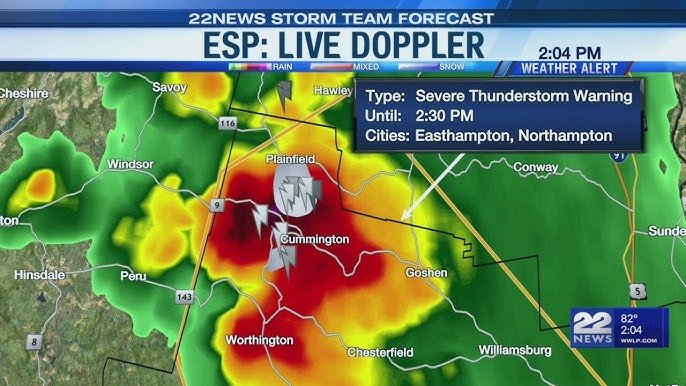Imagine a quiet summer afternoon suddenly disrupted by dark, roiling clouds and fierce winds. As the skies darken, the air becomes charged with anticipation and dread. This is the moment when a Severe Thunderstorm Warning (S.A.M.E code: SVR) might be issued—a crucial alert signaling an imminent or ongoing severe thunderstorm. For those unprepared, such a warning can be a bewildering and frightening experience, but understanding it can make all the difference.
In the United States, severe thunderstorms are responsible for significant damage and occasionally loss of life. In 2022 alone, severe storms caused approximately $1 billion in damages and numerous injuries across the country. Knowing how to interpret and act on a Severe Thunderstorm Warning is essential for minimizing risk and ensuring safety. This article delves into the intricacies of these warnings, their significance, and practical steps to take when one is issued.
Understanding the different levels of severity, knowing where to receive alerts, and what actions to take can all significantly impact your safety during these volatile weather events. With detailed insights and actionable advice, this guide will help you navigate through the storm with confidence and preparedness.
What is a Severe Thunderstorm Warning?
A Severe Thunderstorm Warning is a critical alert issued by the National Weather Service (NWS) when severe weather conditions are detected or anticipated. This warning indicates that a thunderstorm meeting specific criteria is either occurring or imminent in your area.
Criteria for Issuance
Severe Thunderstorm Warnings are issued when:
- Winds reach speeds of 58 mph (93 kph) or greater.
- Hail is 1 inch (2.5 cm) in diameter or larger.
Contrary to common belief, these warnings are not based solely on heavy rain or frequent lightning, though these factors can contribute to the overall severity of the storm.
Where to Receive Alerts
Severe Thunderstorm Warnings are disseminated through various channels to ensure wide coverage and timely information. These include:
- NOAA Weather Radio: Continuous broadcasts with up-to-date weather information.
- Television: Most TV stations broadcast weather alerts during severe weather.
- Radio: Many FM/AM radio stations provide weather updates and alerts.
- Cell Phones: Wireless Emergency Alerts (WEA) can send notifications directly to your mobile device based on your location.
Types of Severe Thunderstorm Warnings
Severe Thunderstorm Warnings are categorized based on the severity of the storm’s impacts. Each level of warning reflects increasing levels of potential damage and danger.
| Warning Level | Wind Gusts | Hail Size | Emergency Alert |
|---|---|---|---|
| Base | 60 mph (97 kph) | 1 inch (2.5 cm) | No |
| Considerable | 70 mph (113 kph) | 1.75-2.50 inches (4.4-6.4 cm) | No |
| Destructive | 80 mph (129 kph) | 2.75 inches (7 cm) or larger | Yes |
| Extremely Destructive | 90+ mph (145+ kph) | 2.75 inches (7 cm) or larger | Yes (PDS) |
- Base: Indicates a severe thunderstorm with high winds or hail that can cause minor damage.
- Considerable: Reflects more significant winds or hail capable of causing moderate damage.
- Destructive: Alerts to extremely severe conditions with high winds or large hail that can cause widespread damage.
- Extremely Destructive: The highest level, signaling storms that are capable of causing extreme damage and may prompt special alerts.
What to Do When a Severe Thunderstorm Warning is Issued
When you receive a Severe Thunderstorm Warning, follow these steps to ensure your safety:
- Seek Shelter: Move to a substantial building or a vehicle with closed windows. Avoid mobile homes and temporary structures that may be unsafe.
- Avoid Electrical Devices: Refrain from using wired electronics. Opt for battery-powered devices to prevent electric shock from lightning strikes.
- Stay Indoors: Avoid activities in water, including swimming pools, lakes, and oceans. Heavy rain can conceal dangerous conditions.
- Stay Informed: Continue to monitor weather updates from reliable sources. Stay tuned to NOAA Weather Radio, TV, or mobile alerts.
Impact of Severe Thunderstorms
Severe thunderstorms can cause a range of hazards, including:
- Wind Damage: High winds can uproot trees, damage structures, and lead to power outages.
- Hail Damage: Large hail can dent vehicles, break windows, and damage crops.
- Flooding: Intense rainfall can lead to flash floods, especially in low-lying areas.
- Lightning: Lightning strikes can cause fires and electrical hazards.
Statistics and Data
Here are some key statistics about severe thunderstorms and their impact:
| Year | Number of Severe Thunderstorms | Total Damage ($ Billion) |
|---|---|---|
| 2022 | 400+ | 1.2 |
| 2021 | 350+ | 0.9 |
| 2020 | 300+ | 1.1 |
These figures highlight the frequency and economic impact of severe thunderstorms in recent years. The cost of damages emphasizes the importance of preparedness and timely response to warnings.
NWS Example
159
WUUS56 KSTO 101209
SVRSTO
CAC005-009-017-057-061-067-099-109-115-101245-
/O.NEW.KSTO.SV.W.0002.230110T1209Z-230110T1245Z/
BULLETIN - IMMEDIATE BROADCAST REQUESTED
Severe Thunderstorm Warning
National Weather Service Sacramento CA
409 AM PST Tue Jan 10 2023
The National Weather Service in Sacramento has issued a
* Severe Thunderstorm Warning for...
Southwestern Tuolumne County in northern California...
Northeastern Sacramento County in central California...
Northeastern Stanislaus County in central California...
Western El Dorado County in northern California...
Southwestern Placer County in central California...
Calaveras County in northern California...
Southeastern Yuba County in central California...
Southwestern Nevada County in northern California...
Amador County in northern California...
* Until 445 AM PST.
* At 407 AM PST, severe thunderstorms were located along a line
extending from 5 miles east of Lincoln to Turlock, moving east at
45 mph.
HAZARD...60 mph wind gusts.
SOURCE...Radar indicated.
IMPACT...Expect damage to roofs, siding, and trees.
* Locations impacted include...
Folsom, Oakdale, Auburn, Placerville, Sonora, Jackson, San Andreas,
El Dorado Hills, Cameron Park, Paloma, Waterford, Lake Of The
Pines, Ione, Loomis, Rancho Murieta, Colfax, Rescue, Valley
Springs, Rail Road Flat and Smithflat.
PRECAUTIONARY/PREPAREDNESS ACTIONS...
For your protection move to an interior room on the lowest floor of a
building.
Torrential rainfall is occurring with these storms, and may lead to
flash flooding. Do not drive your vehicle through flooded roadways.
&&
LAT...LON 3751 12071 3908 12128 3918 12091 3778 12020
3773 12030 3773 12033 3770 12034
TIME...MOT...LOC 1207Z 288DEG 74KT 3843 12092 3748 12065
TORNADO...POSSIBLE
HAIL THREAT...RADAR INDICATED
MAX HAIL SIZE...<.75 IN
WIND THREAT...RADAR INDICATED
MAX WIND GUST...60 MPH
$$
DFR/CH
Examples
See more here.
Conclusion
Severe Thunderstorm Warnings are vital tools for protecting lives and property during extreme weather events. By understanding the criteria for these warnings, knowing where to receive them, and following safety guidelines, you can better prepare for and respond to severe thunderstorms. With the right knowledge and preparedness, you can navigate through these intense storms safely and effectively.
Frequently Asked Questions (FAQs)
What is the difference between a Severe Thunderstorm Warning and a Severe Thunderstorm Watch?
A Severe Thunderstorm Watch means conditions are favorable for severe thunderstorms to develop, whereas a Severe Thunderstorm Warning indicates that severe storms are either occurring or imminent.
How can I prepare for a Severe Thunderstorm?
Ensure you have a battery-powered weather radio, charge electronic devices, and secure outdoor objects that could become projectiles.
What should I do if I am caught outside during a Severe Thunderstorm?
Seek shelter immediately in a building or vehicle. Avoid open fields, tall objects, and bodies of water.
Can Severe Thunderstorm Warnings be updated or canceled?
Yes, the NWS can update or cancel warnings based on evolving weather conditions. Always stay tuned to the latest updates.
How can I receive Severe Thunderstorm Warnings if I don’t have a weather radio?
You can receive alerts through TV, radio, and mobile phone notifications.
Are Severe Thunderstorm Warnings issued for every thunderstorm?
No, warnings are issued only for severe thunderstorms meeting specific criteria related to wind speed and hail size.


